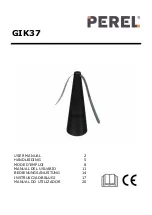
cod. F07011381
USE AND MAINTENANCE
ENGLISH
EN - 61
4.4 TRANSPORT
If it becomes necessary to transport the machine for a long distance, it can be loaded onto a railway wagon or a truck. For this purpose,
consult «Technical Data» for weight and speci
fi
c dimensions. The latter are very useful to check the possibility of driving along all types
of roads.
The machine is generally supplied in a horizontal position with no packing material.
It is therefore necessary to use a system of hoisting with a crane and cables, or chains of adequate capacity, hooking onto the machine
at the hoisting points marked with the «hook» symbol (
fi
g.6
).
CAUTION
Before proceeding to the hoisting op- erations, make sure that any any mo- bile elements of the machine are blocked. Make
sure to use a crane with an adequate hoisting capacity to lift the machine. Hoist the machine with extreme caution and transfer
it slowly, without jerks or abrupt movements.
DANGER
The operations of hoisting and trans- port can be very dangerous if not carried out with the maximum caution; persons not
directly involved should be moved away. Clean, evacuate the area and delimit the transfer zone. Check the state, condition
and suit- ability of the means at disposition. Do not touch suspended loads, keep- ing them at a safe distance.
It most be further ascertained that the operational area is free of obstacles and that there is suffi cient «escape space», mea-
ning an area which is free and secure into which one could move rapidly in case a load should fall. The surface on which the
machine is to be loaded must be horizontal in or- der to prevent possible shifting.
Once the machine is positioned on the vehicle, make sure that it remains blocked in its position. Fasten the machine on the platform of
the vehicle by means of cables suitable for the mass which must be blocked (see «Technical Data» for the weight).
The cables must be
fi
rmly fastened to the machine and pulled taut to the anchorage point on the platform. Once transport has been
carried out and before freeing the machine from all its fastenings, make sure that its state and position are such as not to constitute
danger. Remove the cables and proceed to unloading with the same means and methods used for loading.
Transit and transporting on the public highways
When driving on the public roads,
fi
t on the rear re
fl
ector triangles, side lights and
fl
ashing beacon and always make sure that you
comply with the Highway Code and any other applicable regulations.
Make sure that the machine dimensions during transfer phases allow for safe transport when travelling in subways, along narrow roads,
near electrical lines, etc..
ATTENTION
Before driving on to the public roads with the machine hitched to the tractor, make sure that the devices listed above and/or
the slow vehicle signal and/or the projecting load signal op- erate correctly. These indicators must be affi xed to the rear of the
implement in a position where they can be clearly seen by any other vehicle that drives up behind.
The tractor used for transporting the equipment must have the powers shown in the
Technical Data
table; if necessary, redistribute the
total weights with the addition of ballasts to return balance and stability to the whole assembly.
For displacements beyond the work area, the equipment must be placed in the transportation position:
- Where provided for, make all the moving parts come within the transport width, locking them with the safety devices (toolbars, row
marker arms, row marker discs, etc.).
- Any transport accessories must be provided with suitable signs and guards.
Upon request the Manufacturer will supply supports and tables for signaling of dimensions.
4.5 HYDRAULIC SYSTEM
Once these preliminary operations have been accomplished (coupling of 3-point hitch to the tractor and cardan shaft engagement), connect
the hydraulic system (fi g.22) to the tractor. This will enable the harrow to accomplish its various movements, i.e.:
- The pipes of the two hydraulic cylinders «A» to open (work position) and close (transport position) the two transmission units;
- The pipes of the two hydraulic cylinders «B» to regulate the rear rollers that establish the work depth.
NOTE: The cylinders «C» that operate the closing clips are controlled in sequence with the cylinders that control the units. A spe-
ci
fi
c control is therefore not required.
Recognizing the pipe functions
All hydraulic pipes on the machine have recognition stickers as indicated in fi g.22:
1
: Rear roller lowering.
2
: Rear roller lifting.
3
: Vertical closing of side units.
4
: Horizontal opening of side units.
NOTE: The two cylinders «A» (fi g.22) are equipped with an block valve which acts if a pipe breaks.
Содержание JUMBO RAPIDO 6000
Страница 6: ...6 cod F07011381...
Страница 41: ...cod F07011381 USO E MANUTENZIONE ITALIANO IT 41...
Страница 42: ...42 cod F07011381...
Страница 77: ...cod F07011381 USE AND MAINTENANCE ENGLISH EN 77...
Страница 78: ...78 cod F07011381...
Страница 113: ...cod F07011381 GEBRAUCH UND WARTUNG DEUTSCH DE 113...















































